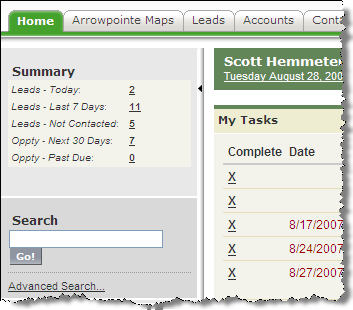Sidebar Summary using Visualforce
About a year ago, I posted about the Sidebar Summary. The Sidebar Summary exists in the Salesforce.com sidebar and displays the counts of some important queries. The counts are also hyperlinks to a view or report representing that query. It’s a very handy thing to have in your sidebar and I use it all the time for my own work. However, because it’s an s-Control, it runs a little slow. In fact, it ran slow enough to make me uncheck the user interface option “Show Custom Sidebar Components on All Pages”.

I changed it into a Visualforce page with a custom Apex controller and now it runs super fast and I am able to keep the “Show Custom Sidebar Components on All Pages” option turned on and see it on every page I go to. There’s a bit of hardcoding in here, but it gets the job done pretty well. Bye bye s-Control.
Visualforce
The Page is almost all raw HTML. The only dynamic thing in there are the count values. Each one retrieves the value from a specific “get” method in the controller. If you like the queries I use, then the only thing you’ll need to confirm are the URLs that get linked to. The first 2 go to Views in my Org and the last 2 go to Reports in my Org. You’ll need to change those URLs.
I named the VF Page “SidebarSummary”.
<apex:page controller="VFController_Sidebar_Summary" sidebar="false" showHeader="false" standardStylesheets="true">
<style type="text/css" media="all">
body{margin: 0; padding: 0; color: #000000; background-color: #E8E8E8;}
#DIV_Container {background-color: #F3F3EC;}
</style>
<div id="DIV_Container">
<table>
<tr><td><em>Unread Leads</em>: </td><td><a href="/00Q?fcf=00B30000005JhsT" target="_parent"><b>{!UnreadLeads}</b></a></td></tr>
<tr><td><em>Leads - Not Contacted</em>: </td><td><a href="/00Q?fcf=00B30000005Jhru" target="_parent"><b>{!NotContactedLeads}</b></a></td></tr>
<tr><td><em>Oppty - Next 30 Days</em>: </td><td><a href="/00O30000001aEHV" target="_parent"><b>{!Next30DayOppty}</b></a></td></tr>
<tr><td><em>Oppty - Past Due</em>: </td><td><a href="/00O30000001aEHV" target="_parent"><b>{!PastDueOppty}</b></a></td></tr>
</table>
</div>
</apex:page>
Apex
The controller has a method for each query to be run. Each query is a count() query and returns an Integer. At the end is a really lame Test method, but it does get 100% of the code covered. I am certain the code works, so I didn’t do too much with the Test method. Salesforce just requires the code to be tested.
public class VFController_Sidebar_Summary {
public Integer getUnreadLeads() {
return [
select count() from Lead
where IsConverted = False
AND IsUnreadByOwner = TRUE
];
}
public Integer getNotContactedLeads() {
return [
select count() from Lead
where IsConverted = False
AND Status = 'Open - Not Contacted'
];
}
public Integer getNext30DayOppty() {
return [
select count() from Opportunity
where IsClosed = False
AND (CloseDate = Next_N_DAYS:30 OR CloseDate = TODAY)
];
}
public Integer getPastDueOppty() {
return [
select count() from Opportunity
where IsClosed = False
AND CloseDate < TODAY
];
}
static testMethod void testVFController_Sidebar_Summary() {
Test.setCurrentPageReference(new PageReference('Page.SidebarSummary'));
VFController_Sidebar_Summary controller = new VFController_Sidebar_Summary();
Integer i1 = controller.getUnreadLeads();
Integer i2 = controller.getNotContactedLeads();
Integer i3 = controller.getNext30DayOppty();
Integer i4 = controller.getPastDueOppty();
}
}
[/sourcecode]
<span style="text-decoration: underline;"><strong>Homepage HTML Component</strong></span>
I created a component for the Narrow side and put the following HTML into the editor. Essentially, you create an IFRAME and embed the VF page into it. I found a (unsupported) trick on the forums to remove the developer bar from a page. Just add <strong>?core.apexpages.devmode.url=1</strong> to the URL. This will turn off development mode when that page is rendered. This is important for this little iFrame page on the sidebar. From what I've gathered, this hack is not supported and could change at any time.
The code below should work for you. The only thing you might need to change is the Page URL if you didn't name your page SidebarSummary and the height of it.
<iframe src="/apex/SidebarSummary?core.apexpages.devmode.url=1" frameborder="0" height="100" width="100%"></iframe>
Let me know what you think.